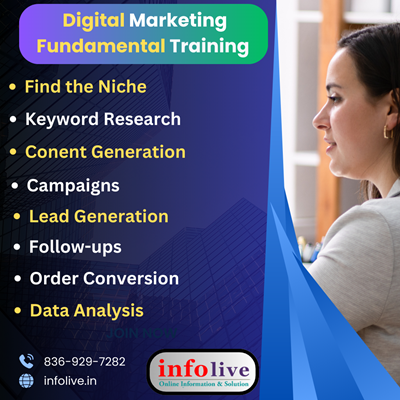Infolive gives you basic training in digital marketing by doing keyword research, content creation, campaigns, lead generation, lead follow-ups by CRM software, order conversion then data analysis which has eight point man covers which are below.
 |
|
- Find The Niche
- Keyword Research
- Content Generation
- Campaigns
- Lead Generation
- Follow-ups
- Order Conversion
- Data Analysis
|
In today's fast-paced and ever-evolving business landscape, digital marketing has emerged as an important tool to reach and connect with customers.
By leveraging the power of various digital channels through digital marketing and the Internet, businesses can promote their products, services, and brand messages to a global audience. Not only this but digital marketing offers unique opportunities for targeting, personalization, and data-driven decision making. Let us delve deep into the world of digital marketing and explore its different types.
The following are the types of digital marketing:
- Search Engine Optimization (SEO): SEO is the process of optimizing the content, structure, and technical aspects of a website in order to improve its visibility on search engine result pages (SERPs). The goal is to systematically rank high on Google for relevant keywords, thereby driving more organic (non-paid) traffic to the website.
-
- Search Engine Marketing (SEM): SEM involves paid advertising on search engines. This includes pay-per-click (PPC) campaigns, where advertisers bid on keywords to have their ads appear prominently on search results. Google Ads is a widely used platform for SEM.
-
- Content Marketing: Content marketing focuses on creating valuable and relevant content to attract and engage the target audience. This can include blog posts, articles, infographics, videos, and more. Its purpose is to build trust and authority by indirectly promoting products or services.
-
- Social Media Marketing: Social media platforms such as Facebook, Instagram, Twitter, and LinkedIn provide businesses with powerful tools to connect with their audiences.Social media marketing involves creating and sharing content, running paid advertising, and boosting engagement to build loyal followers.
-
- Email Marketing: Email marketing is an effective way to communicate directly with customers. This includes sending targeted emails to a subscriber list and sharing promotions, news, updates, and personalized content.
-
- Influencer Marketing: This strategy involves collaborating with influencers or individuals with significant online followings to promote products or services. Influencers can influence the opinions and behavior of their audiences.
-
- Affiliate Marketing: In affiliate marketing, businesses partner with affiliates who promote their products on their websites or platforms. Affiliates earn a commission for each sale generated through their referral link.
-
- Video Marketing: Video has become a dominant form of content online. Video marketing involves creating and sharing videos on platforms such as YouTube, or Instagram to showcase products, demonstrate features, tell stories, or provide value.
-
- Display Ads: Display ads are graphical ads that appear on websites, apps, and social media platforms. These ads can be static or interactive and can be targeted to specific demographics, interests, and behaviors.
-
- Mobile Marketing: With the rise of mobile devices, mobile marketing focuses on delivering targeted ads, apps, and content to users on their smartphones and tablets.
-
- Native Ads: Native Ads are designed to match the look and feel of the platform on which they appear. They blend in with the surrounding content and provide a seamless user experience.
-
- Remarketing/Retargeting: This strategy involves showing targeted ads to users who have previously interacted with a brand's website, encouraging them to return and complete desired actions.
-
- Digital marketing is a dynamic field, constantly adapting to technological advancements and changing consumer behavior. The most successful campaigns often combine multiple types of digital marketing to create a cohesive and impactful online presence. As businesses continue to move into the digital landscape, it is important to understand these different strategies and their potential benefits in order to achieve marketing success in the modern age.